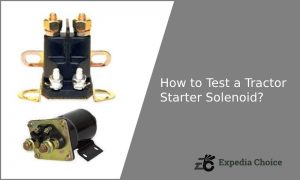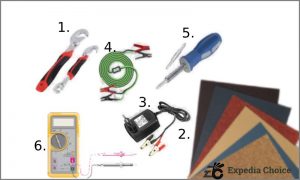 Lawnmowers and tractors are quite useful vehicles that we are so used to today. These are pretty valuable when it comes to dealing with high grass and bushes.
Lawnmowers and tractors are quite useful vehicles that we are so used to today. These are pretty valuable when it comes to dealing with high grass and bushes.
So, one fine morning, you decide to get into your trusted tractor and start the switch or turn key. But at your disappointed, there’s a slightly audible click sound and nothing else. It Does Not Start at All!
Now there could be a few things causing this. Maybe your battery is showing low. However, if the battery is fully charged and still, it’s not starting, then my friend there’s a trouble with engine starter motor most probably.
And in some cases, it’s the solenoid. A handy guide on how to test a tractor starter solenoid can really help you here.
Testing a Tractor Starter Solenoid: Keep It Simple by Knowing All.
If your tractor uses the electrical starting system then it has a part called starter solenoid. We are here to test that particular part. You are going to need some basic hand tools and know what does the solenoid do on a starter. These basic ideas are important to test this part.
The solenoid with its cylindric design is basically a low-amperage relay. It is here to complete the connection of high-amperage. The engaging happens between starter motor and battery of tractor. The ignition key stays on to make this connection happen.
With a disturbing solenoid, the electrical transfer gets denied. And so, there is no electricity flowing to start the motor and prevents it from turning on.
Get Some Things:
- Multiple wrenches in a set.
- Sandpaper (medium grit ones are preferable).
- Battery charger.
- Jumper cable.
- Screwdriver.
- Working voltmeter.
How to Check a Starter Solenoid of Tractor & Repair?
Here’s how can you tell if starter solenoid is bad through doing various checkups. There are quite a few but let me talk about some common ones below. Also, read…
Checking Charge Level.
Take the voltmeter and simply touch its red lead with a positive post of battery. Let the black lead connect with negative post of battery. This is to find out the charge level.
If you witness the reading is lower than 12.5 volts, it needs charging up. This is how test starter solenoid that lacks the right volts for starting up.
Check All Electrical Connections.
You need to test whether every connection between solenoid, starter and battery are right. There should be a few electrical connections between these elements that could be affected by corrosion. Sometimes, due to this problem, the startup does not happen.
You can easily locate the battery part beneath operator’s seat in engine compartment. The starter motor is a cylinder metal piece that’s vertical. It should stay mounted on the side of engine with 6 inches length.
The solenoid pat is a tiny cylinder that stays attached with a lawn tractor’s frame. It’s closer to the starter motor side. There should be two thick wires attached to the solenoid. One brings a connection from the battery. The other one is from starter motor.
There should be another thin wire. This is coming from ignition key for activating solenoid once the start position is turned on. There is a distinct tiny grounding wire as well. Make sure you check all of these wires.
If there’s any corrosion noticeable then simply clean it up. For this, you will disconnect the battery and use a wrench or screwdriver next. Use the tool to simply undo those corroded connections.
Now use sandpaper to get rid of those corrosions. Once these are bright enough to look clean, connect them back. Make sure there’s no loose connection.
Now bring the gearshift to neutral and mower deck to disengagement. Set the parking brake and reconnect battery. Try starting the engine and it should work.
Replacement Testing.
If the corrosion is not a problem, continue testing. Start by turning the ignition key on. Now go to the solenoid and look for huge terminal posts. This is where the red thick wires connect to solenoid.
At the huge terminals, you should bring screwdriver’s metal shaft part and touch it. If you notice the engine starting up this time, solenoid has been damaged completely. It needs replacement.
If the engine still disagrees with startup then motor itself is defective. You may have to look for the large terminals on solenoid’s opposite side in a few models. You can easily implement a jumper cable in such a case and connect them.
Extra Note:
There are many models of engine that uses integrated set up for motor and solenoid. So, they might not be replaceable separately.
The Right Time to Check?
When you try to start your tractor, the spark should fire motor. This should activate the little gear moving. So that the movement of engine’s larger gear can happen.
Basically, when the engine starts up, it should first make clicking and then a whirling sound. However, things are not the same with a bad solenoid.
What does a bad starter solenoid sound like? It actually makes no sound at all sometimes. However, in a few cases, there will be only the clicking sound.
Here are some symptoms that your starter’s solenoid is in trouble:
No action seems to happen with ignitions engaging. And one of multiple reasons could be solenoid damage.
A solo clicking sound seems to come from the vehicle’s engine compartment. This notifies that solenoid is attempting to start the engine but an internal component is not letting it work properly.
You can hear clicking sound continuously. This means either your system’s battery is dead or the solenoid is unable to make enough electrical contact inside.
Another dangerous symptom is your tractor’s engine seems to start itself. This may be a seriously damaged solenoid issue that needs instant attention from a pro.
If there’s starter engaging but no disengaging happens with the key release, it’s a seriously damaged solenoid. You can suffer from further damage with such a defective part.
You experience the tractor to start occasionally. Sometimes it starts and other times it does not. You want to get ready for repairing or replacement in such scenarios.
Warning.
Your PTO should be in neutral while checking these and also keep the throttle on stop position. This is a pretty dangerous process and so if you are not confident enough, let someone expert deal with it.
Conclusion
There are more than a few ways on how to test a tractor starter solenoid. But I tried to keep everything included keeping the novices and absolutely no-clue-having folks. So that you can easily find the fault inside your beloved tractor and sort it out as soon as possible.
However, sometimes the only reason you have to face such boring tests and checks is due to a lack of proper maintenance.
You can always take your tractor or lawnmower for periodic testing or maintenance to a local auto workshop. This can lead you to enjoy the longevity of your tractor without any problems.